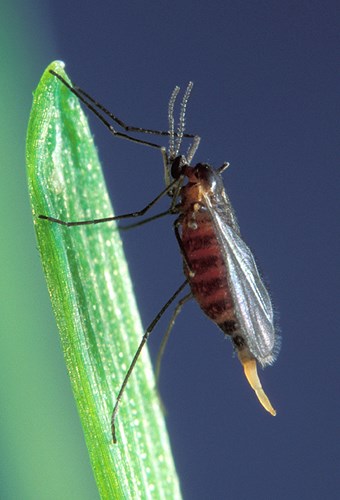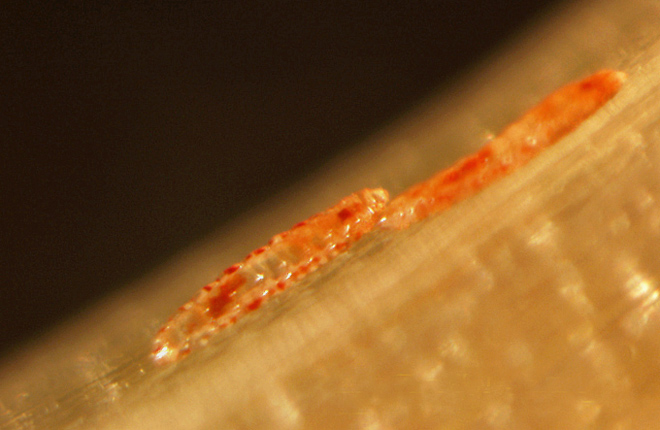Genetics Helps Wheat Fight Hessian Fly
Scientists around the world are searching for ways to combat the Hessian fly (Mayetiola destructor), a significant insect pest in cereal crops like wheat, barley, and rye. These insects lay eggs on the plant’s leaves, and the growing larvae use chemical warfare to hijack the plant’s genes to benefit themselves, causing severe plant stunting and inability to produce seeds.
Agricultural Research Service (ARS) molecular biologist Christie Williams and her colleagues in West Lafayette, Indiana, discovered a new wheat gene, called H33, that protects the crop against Hessian fly attack. This gene is effective throughout the United States, but it is desperately needed in the Southeast, where Hessian fly resistance in older wheat varieties is failing.
 An adult Hessian fly on a leaf. (Scott Bauer, K4193-19) |
Initially, the research that identified H33 did not detect molecular markers that were close enough to the gene to be useful for marker-assisted selection—a streamlined plant-breeding method. Consequently, this much-needed gene could not be used efficiently by breeders.
“Without close markers, the resistance gene could be lost during the breeding process, leaving the new cultivar still susceptible to the insect,” says Williams. “In addition, if the markers aren’t close enough to the gene, undesirable genes that are near H33 could be dragged along with the markers into the receiving wheat genome. Those tag-along genes can decrease seed quality or cause the crop to become susceptible to other diseases.”
In order to locate markers that were close enough to H33, Williams and her colleagues devised an unusual strategy aided by high-throughput DNA sequencing to target their search to a small region of the chromosome that contained the resistance gene. “The strategy let us find that needle in the haystack,” Williams says.
The targeting strategy led Williams to discover five new markers that are very close to H33. “These markers were converted into a convenient and inexpensive format for breeders to use while moving the H33 gene into new cultivars.”—By Sharon Durham, ARS Office of Communications.
Key Facts
- The Hessian fly damages wheat and other cereal crops.
- ARS found a gene, H33, that makes wheat resistant to Hessian fly.
- Genetic markers help breeders move the gene into new wheats.
- ARS scientists devised a strategy to find markers for the H33 gene.
Full Story







